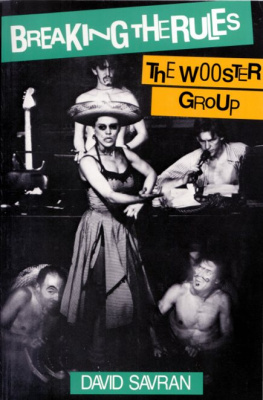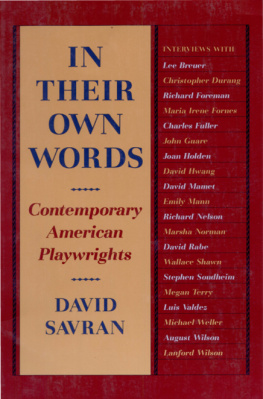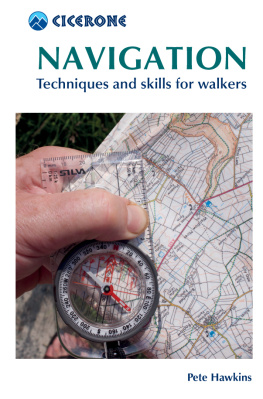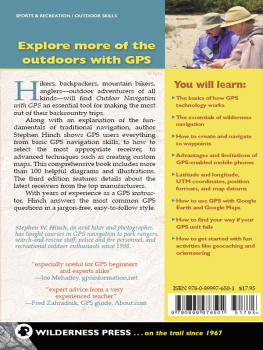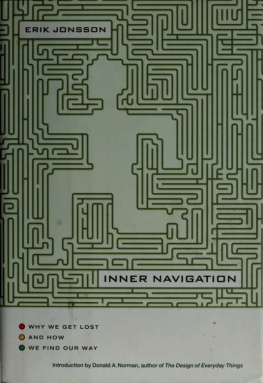BREAKING THE RULES
BREAKING THE RULES
THE WOOSTER
GROUP
DAVID SAVRAN
Theatre Communications Group New York 1988
Copyright 1986 by David Savran
Breaking the Rules: The Wooster Group is published by Theatre Communications Group, Inc., 520 Eighth Avenue, 24th Floor, New York, NY 10018-4156.
All rights reserved. Except for brief passages quoted in newspaper, magazine, radio or television reviews, no part of this book may be reproduced in any form or by any means, electronic or mechanical, including photocopying or recording, or by an information storage and retrieval system, without permission in writing from the publisher.
Originally published under the title The Wooster Group, 19751985 by UMI Research Press, an imprint of University Microfilms, Inc., Ann Arbor, MI 48106.
This publication is made possible in part with public funds from the New York State Council on the Arts, a State Agency.
TCG books are exclusively distributed to the book trade by Consortium Book Sales and Distribution, 1045 Westgate Drive, St. Paul, MN 55114.
Library of Congress Cataloging-in-Publication Data
Savran, David, 1950
Breaking the rules.
Originally published: The Wooster Group, 19751985.
Ann Arbor, Mich. : UMI Research Press, 1986.
Bibliography: p.
Includes index.
1. Wooster Group. 2. Experimental theaterNew York (N.Y.) 3. American drama20th CenturyHistory and criticism. I. Savran, David, 1950 . Wooster Group, 19751985. II. Title. PN2277.N52W6671988 792.097471 88-4894
ISBN:978-1-5593-6709-7
On the cover: Ron Vawter, Kate Valk, Matthew Hansell, Willem Dafoe and Jeff Webster (microphone) in L.S.D. Part IV.
Photograph copyright 1988 by Paula Court, used by permission
Cover design by G&H/Soho Ltd.
First Edition, April 1988
Fourth Printing, March 2005
To my father,
Jack Savran, M.D.
Perhaps... we shall still discover the realm of our invention, that realm in which we, too, can still be original, say, as parodists of world history and Gods buffoonsperhaps, even if nothing else today has any future, our laughter may yet have a future.
Friedrich Nietzsche
INTERLOCUTOR: Tambo, I understand you were at the cemetery yesterday.
TAMBO: Yessuh!
INTERLOCUTOR: Who died?
TAMBO: Everybody in the graves.
INTERLOCUTOR: No, I mean what friend or relative was buried?
TAMBO: No one.
INTERLOCUTOR: Then why did you go to the cemetery?
TAMBO: I went there to read the epitaphs on the tombstones.
INTERLOCUTOR: Thats a funny way of spending your time.
TAMBO: Thats where I get all my material for my jokes.
Blackface and Music: A New Minstrel Folio (1936)
The complicity of cultural criticism with culture lies not in the mere mentality of the critic. Far more, it is dictated by his relation to that with which he deals. By making culture his object, he objectifies it once more.
Theodor Adorno
Contents
There are many ways to react to the Wooster Group. You can become absorbed in the arcana and minutiae that eventually recombine to form the densely layered textures of their pieces (as David Savran rather remarkably does in this study), or you can just sit back and take it all in as the high-energy show-biz media-blitzed theatrical grandslam that it is. The latter course was tried with great success by uninitiated urban and suburban audiences in Boston a couple of years ago when even the 11:00 p.m. news critics had a great time with L.S.D.
And because there is so much detail, too much certainly to be taken in during a single performance, each viewers experience of the work is quite different. And the pieces themselves are constantly changingfor every performance Liz is busy adding or deleting or speeding something up or slowing it downless, it seems to me, out of any attempt to get closer to some imaginary ideal of a finished performance than simply as an attitude, and a way of thinking and living. I have probably seen L.S.D. about thirty times now, and I still get sharply different takes from every performance.
I must admit that my own first encounter with the Wooster Group (it was their especially indigestible Route 1 & 9) left me enraged and annoyedit is hard to say which was worse. Then some months later they mounted a retrospective of their work and I was quite overwhelmed. First off, there are very few companies in our country which can point to a body of new work, manage to revive it across a month, and then have it stand the test of time. But as I saw this body of work, a lyricism and classical repose began to emerge that I had not noticed beneath the busy surface level, and eventually the uncompromising search to confront actual subject matter at the most literal level began to show through. And in how many theaters besides the ballet, opera, and circus can one speak of a spectacular level of technique on the part of the performers. In her search for verisimilitude, Liz employs actors with little or no stage experience, children, and a highly skilled core of virtuoso performers. And as with the best work, they do get under your skin and provoke strong reactions. And its high time. Theater-going in our day has become a predictable act of lip-synching to the hoariest old commonplacesThe Wooster Group restores fire, outrage, scandale, and the sensation of something new. Theater as an art form is traditionally twenty to fifty years behind painting, music, dance, and the novel. The Wooster Group is upto-date.
And I think that whether one likes the work or not is really rather beside the pointit constitutes an event, something that must be seenit will be important to have been there. Anyone with any interest in theater in the United States of America in 1986 owes it to themselves to know what some of the latest developments are. If theater in the United States is to become large again, the Wooster Group is out there, up ahead, scouting the way. They are inventing theatrical vocabulary that ten and twenty years from now will become the lingua franca of a revivified American Theater. For my money, they are the most important theater company in our country today.
Peter Sellars
Director
American National Theater
May 1986
I wish to acknowledge, above all, the unflagging assistance, support and generosity of all of the members and associate members of the Wooster Group. I am especially grateful to Elizabeth LeCompte, who helped and inspired me every step of the way (and who provided the synopses of the pieces herein); Ron Vawter, who gave me invaluable feedback and encouragement; and Norman Frisch, who worked with me very closely and helped immeasurably in developing and clarifying my ideas.
The University of Regina granted me a sabbatical leave to finish the book, for which I am grateful, as well as assistance from the Presidents Fund in covering my many trips to New York. And I thank my students at the University, past and present, for teaching me to ask the right questions.
I am grateful to The Drama Review for allowing me to reprint material that appeared in my article, The Wooster Group, Arthur Miller and The Crucible.
I am obliged to many people who lent their time and encouragement, including Betty Corwin, Laura Ross, Nancy Campbell, Gabriel Prendergast, Bonnie Jackson, Tim Jensen and my superb editor at UMI, Sundra Flansburg. I wish also to acknowledge my longstanding debt to Bert States. Finally, I must express my heartfelt appreciation to all my friends who nourished me in this effort. I am especially grateful to Paula Vogel, for her enthusiasm and her thoughtful and incisive criticism of the manuscript; David Hult, for giving me perspective; and Ronn Smith, for his patience, watchful eye and unwavering support.

